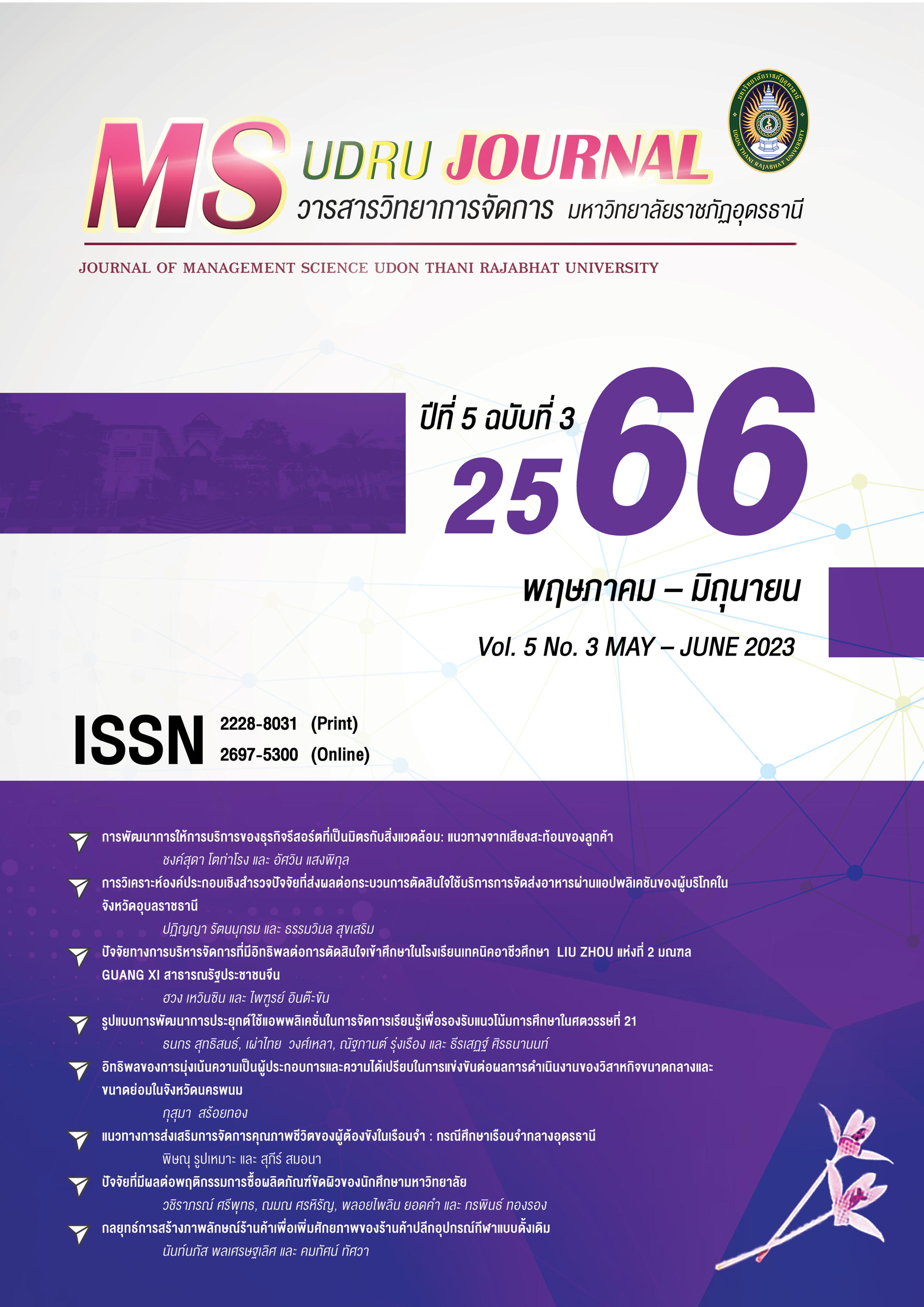VISUAL MERCHANDISING STRATEGY FOR POTENTIAL DEVELOPMENT OF TRADITIONAL SPORTING GOODS RETAIL STORES
Main Article Content
Abstract
The purposes of this research were to study a structural equation model for visual merchandizing for a traditional retail sporting goods store and propose business strategies to create competitive advantages. A quantitative research method was employed to collect data from a sample of 657 people who had experience shopping at a traditional sporting goods retailer. The research tool was an online questionnaire. The descriptive statistics used comprised of frequency, percentage, mean, and standard deviation. The analysis and conclusions of the research involved exploratory factor analysis techniques and confirmatory factory analysis. The research results showed that: 1. Factors for creating visual merchandising elements including merchandising display, store layout, window display, point-of-purchase display, and store ambiance had statistically significant (p-value = 0.000) positive influence on store benefits, i.e. functional benefits, emotional benefits, and symbolic benefits. 2. Functional benefits had a positive influencing on consumers behavior. The symbolic benefit had a positive influence on purchasing intention, impulse buying, and spending time in stores were statistically significant (p-value = 0.000). The results of this research can be applied to the traditional retail business as a guideline for strategic planning to meet the needs of consumers and increase the competitiveness of the operators of traditional sports equipment retailers
Article Details

This work is licensed under a Creative Commons Attribution-NonCommercial-NoDerivatives 4.0 International License.
บทความที่ได้รับการตีพิมพ์เป็นลิขสิทธิ์ของคณะวิทยาการจัดการ มหาวิทยาลัยราชภัฏอุดรธานี
ข้อความที่ปรากฏในบทความแต่ละเรื่องในวารสารวิชาการเล่มนี้ ไม่ใช่ความคิดเห็นและความรับผิดชอบของผู้จัดทำ บรรณาธิการ กองบรรณาธิการ และคณะวิทยาการจัดการ มหาวิทยาลัยราชภัฏอุดรธานี ความรับผิดชอบด้านเนื้อหาและการตรวจร่างบทความแต่ละเรื่องเป็นความคิดเห็นของผู้เขียนบทความแต่ละท่าน
References
กรมพัฒนาธุรกิจการค้า. (2562). ธุรกิจเครื่องแต่งกายและอุปกรณ์กีฬา. สืบค้นเมื่อ 3 มิถุนายน 2564, จาก https://www.dbd.go.th.
ศิริวรรณ เสรีรัตน์. (2550). พฤติกรรมผู้บริโภค. กรุงเทพฯ: ธีระฟิลม์ และไซเท็ก.
ศูนย์วิจัยกสิกรไทย. (2562). กำลังซื้อหด กดดันการเติบโตของธุรกิจ คาดปี 63 ค้าปลีกขยายตัว 2.8%. สืบค้นเมื่อ 2 มิถุนายน 2564, จาก https://www.kasikornresearch.com.
ศูนย์วิจัยธนาคารออมสิน. (2563). สถานการณ์ธุรกิจค้าปลีก ท่ามกลางการระบาดระลอกใหม่. สืบค้นเมื่อ 2 มิถุนายน 2564, จาก https://www.gsbresearch.or.th.
สมาคมผู้ค้าปลีกไทย. (2562). บทสรุปค้าปลีกไทย’61. สืบค้นเมื่อ 25 ตุลาคม 2564, จาก http://www.thairetailer.com.
สมทบ ฐิตะฐาน. (2560, 27 มิถุนายน). อาจารย์. คณะสังคมศาสตร์และมนุษยศาสตร์ มหาวิทยาลัยมหิดล. สัมภาษณ์.
อภิรดี วงศ์กิจรุ่งเรือง และณัฐพล อัสสะรัตน์. (2560). วิจิตรศิลป์: กลยุทธ์ทางการตลาดใหม่ของร้านค้าปลีก. จุฬาลงกรณ์ธุรกิจปริทัศน์, 39(151), 94-118.
Baumgartner, H.R., & Homburg, C. (1996). Applications of structural equation modeling in marketing and consumer research: A review. International journal of research In marketing, 13, 139-161.
Doll, W. J., Xia, W., & Torkzadeh, G. (1994). A Confirmatory Factor Analysis of the End-User Computing Satisfaction Instrument. MIS Quarterly, 18(4), 453–461.
Hair, J. et. al. (2010) Multivariate data analysis. 7th ed. New Jersey, Upper Sandle River: Prentice-Hall.
Hu, L.-t., & Bentler, P. M. (1999). Cutoff criteria for fit indexes in covariance structure analysis: Conventional criteria versus new alternatives. Structural Equation Modeling, 6(1), 1–55.
Kline, R. B. (1998). Principles and practice of structural equation modeling. Guilford Press.
Smith, J. B. and Colgate, M. (2007). Customer Value Creation: A Practical Framework. Journal of Marketing Theory and Practice, 15(1), 7-23.

